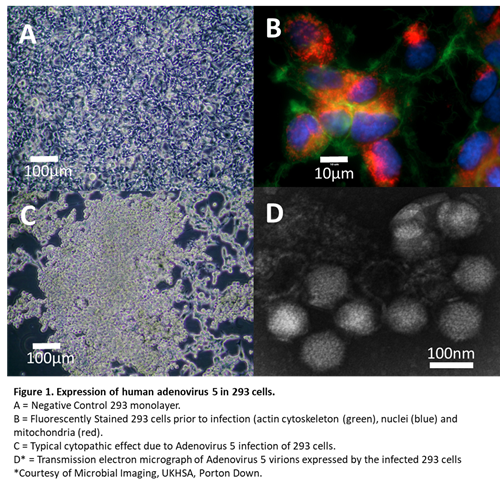The '293' cell line in action: virology research

Adenoviruses (family Adenoviridae) are non-enveloped viruses in the size range of 90–100 nm. They have an icosahedral nucleocapsid that houses a double-stranded DNA genome. The name ‘adenovirus’ is derived from their initial isolation from human adenoids. In humans, adenoviruses cause a wide range of illnesses, from mild respiratory infections to life-threatening multi-organ disease in people with a weakened immune system. Adenoviruses are a commonly used viral vector for gene therapy due to their capacity to accommodate large transgenes and to infect replicating and non-replicating cells without integrating into the host cell genome.
The human embyonic kidney cell line '293' (ECACC 85120602) was originally generated through transformation of human embryonic kidney cells with adenovirus DNA. These cells are often used as a transfection host and in the field of virology. Recently, scientists from the National Collection of Pathogenic Viruses (NCPV) used the 293 cell line as a host to express human Adenovirus 5 (NCPV 0011055v) in cell culture systems whilst exploring the effect of adenovirus infection on cell morphology.
Figure 1 shows the typical morphology of the 293 cell line under standard light microscopy (1A) and when its actin, nuclei, and mitochondria are stained (1B). These healthy 293 cells are in contrast to the typical cytopathic effect (CPE) observed following human Adenovirus 5 infection (1C) where the 293 cells form large floating aggregates. The typical icosahedral morphology of the human Adenovirus 5 virions is shown by transmission electron microscopy (TEM) (1D).
Bibliography:
Biology LibreTexts. 25 June 2017.
Rowe WP, Huebner RJ, Gilmore LK, Parrott RH, Ward TG Proceedings of the Society for Experimental Biology and Medicine. 84 (3): 570–3 (December 1953).
Lee CS et al. Genes & Diseases. 4 (2): 43–63 (June 2017).
